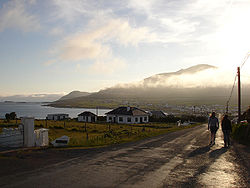Dooagh (Irish: Dumha Acha) is a village located on Achill Island in County Mayo, Ireland. It is best known for the nearby Keem Bay, a Blue Flag beach.
Dooagh
Dumha Acha (Irish) | |
|---|---|
Village | |
 The road to Dooagh, the westernmost village on Achill Island | |
| Coordinates: 53°59′31″N 10°05′02″W / 53.9918954°N 10.0838816°W | |
| Country | Ireland |
| Province | Connacht |
| County | County Mayo |
| Elevation | 30.6 m (100.4 ft) |
| Population | 567 |
Dooagh beach
editBetween May 2017 and January 2019, Dooagh beach had 300 metres (1,000 ft) of golden sand. Previously, the sand was completely washed away in a storm in 1984, leaving a rocky foreshore that remained until the sand was restored by an unusually high tide in April 2017. The new sandy beach was reported as causing an increase in tourism to the village.[2] Dooagh beach washed away for a second time in early 2019.[3]
Transport
editRoad
editDooagh is located on the R319 regional road.
Bus Éireann route 450 (Dooagh—Keel—Westport—Murrisk—Louisburgh) serves the village six times daily on weekdays; three times on Sundays. Connections to Ireland West Airport and Dublin are available at Westport[4]
Rail
editThe nearest rail services are at Westport railway station, 62 km (39 mi) away. There are several trains a day from Westport to Dublin Heuston via Athlone.[citation needed]
Facilities
editDooagh has a number of bed and breakfast establishments and self-catering apartments. There are two public houses, Lourdie's and Gielty's Bar and Restaurant, which sometimes host traditional Irish music sessions. The bar and nightclub in the Wavecrest Hotel is open seasonally.[citation needed]
Places of interest
editThe road to the west of Dooagh leads over Croghaun Mountain to Keem Strand, which has views over Clew Bay. A turning off the Keem Road leads to Lough Acorrymore, surrounded by scree slopes and now dammed to supply water for the entire island.[5] The seaward side of Croghaun has high cliffs, the island's highest.
On the road from Dooagh beach towards Lough Corrymore stands Corrymore House, once the home of Captain Charles Boycott,[5] a British land agent whose ostracism by his local community in Ireland as part of a campaign for agrarian tenants' rights in 1880 gave the English language the verb "to boycott", meaning "to ostracise". Captain Boycott moved to Corrymore House after his residence at Keem was burnt down. The American artist Robert Henri also lived there at one time,[5] having bought the house in 1924.[6]
In the centre of Dooagh is a monument to Don Allum, the ocean rower who was the first to row across the Atlantic in both directions, and who completed this feat on reaching Dooagh village near to this point.[7]
Culture
editAchill has five pipe bands, Dooagh Pipe Band being one of these. Dooagh Pipe Band was founded on 17 March 1947 with a membership of eleven.[8]
Scoil Acla, an Irish traditional music summer school, takes place annually in Dooagh. Scoil Acla was established in 1910. Artist Paul Henry was an active member of Scoil Acla and in 1912 directed the play Casadh an t-Sugain (The Twisting Of The Rope) by Douglas Hyde. The school gradually went into decline, but was revived in 1985.[9]
Education
editDooagh National School serves the Dooagh, Pollagh and Keel areas, and has 36 pupils and two teachers. The school was built in 1959 and renovated in 2001.[10]
Achill Archaeological Field School is based at the Achill Archaeology Centre in Dooagh. It was founded in 1991 and is a training school for students of archaeology and anthropology. The school is involved in a study of the prehistoric and historic landscape at Slievemore, incorporating a research excavation at a number of sites within the Deserted Village of Slievemore.[11]
Dooagh Day
editEach July, on the second weekend of the month, the village plays host to a festival which includes traditional Irish currach racing, food, games, music, and an historical exhibition. The first Dooagh Day took place on Sunday 12 July 2015.[citation needed]
People
edit- Robert Henri (1865–1929), an American artist who came to Achill regularly in the early 20th century. During his early trips to Achill he painted extensively and is reputed to have completed portraits of most of the children in Dooagh village. He bought Corrymore House on the hill above Dooagh in 1924.
See also
editReferences
edit- ^ "Census 2022 Sapmap Area: Settlements Keel-Dooagh". Central Statistics Office (Ireland). Retrieved 16 June 2024.
- ^ McDonald, Henry (8 May 2017). "Irish beach washed away 33 years ago reappears overnight after freak tide". The Guardian. London. Retrieved 8 May 2017.
- ^ "Beach on Achill Island disappears following heavy storms". Raidió Teilifís Éireann. Dublin. 11 January 2019. Retrieved 11 January 2019.
- ^ "Bus Éireann announces improved services and timetables and nine new jobs created in Ballina".
- ^ a b c "Dooagh" (PDF). Achill Tourism. Archived from the original (PDF) on 11 October 2008. Retrieved 7 March 2009.
- ^ "Their portraits are famous in America but - Whatever happened to the Commins family of Achill?". Western People - 1 April 1998. Archived from the original on 22 June 2011. Retrieved 7 March 2009.
- ^ "William Alley and Don Allum black plaque". openplaques.org. Retrieved 17 December 2018.
- ^ "Dooagh Pipe Band". band website. Retrieved 7 March 2009.
- ^ "Scoil Acla Irish Traditional Music Summer School". Scoil Acla. Archived from the original on 6 July 2009. Retrieved 7 March 2009.
- ^ "Dooagh National School". School website. Archived from the original on 5 October 2011. Retrieved 7 March 2009.
- ^ "Achill Archaeological Field School 2009". Achill Archaeological Field School. Archived from the original on 28 February 2009. Retrieved 7 March 2009.
External links
edit
